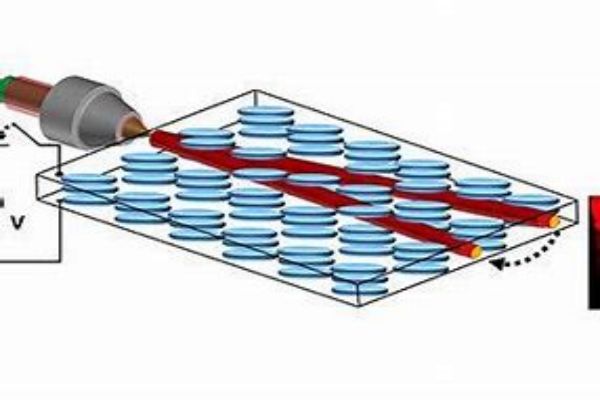Introduction to Laser Crystals
As the world evolves, so does the science behind it. Laser Crystals are a prime example of how scientific advancement has shaped our lives. They play an instrumental role in generating laser beams, the powerhouses behind many modern technologies, from barcode scanners to surgical instruments.

Defining Laser Crystals
Before diving into the mechanism of laser beam generation, let’s first understand what laser crystals are. Laser crystals are a specific category of optical crystals used as gain media for solid-state lasers. The inherent properties of these crystals are exploited to amplify light at specific wavelengths, allowing the creation of intense, focused laser beams.
The Structure of Laser Crystals
The physical structure of laser crystal is a significant factor in their effectiveness in generating laser beams. They possess a periodic arrangement of atoms or ions, forming a crystal lattice. This structural uniformity ensures a stable and predictable interaction between the constituent atoms and the light that passes through.
Dopants in Laser Crystals
Often, laser crystals are doped with specific rare-earth or transition-metal ions to further enhance their lasing properties. This doping process infuses the crystal with additional energy states, which are fundamental to laser operation. For example, in a Nd:YAG laser crystal, the crystal is doped with neodymium ions (Nd) which contribute to the desired laser action.
The Optical Properties of Laser Crystals
Laser crystals have distinct optical properties that enable them to efficiently amplify light. They possess high transparency at the laser wavelength and have a high damage threshold, meaning they can handle the intense light associated with laser beams without undergoing structural damage.
Different Types of Laser Crystals
There are various types of laser crystals, each with unique properties suited to different laser applications. Some commonly used laser crystal include ruby crystals, used in the first-ever working laser, and Nd:YAG crystals, widely used in industrial and medical lasers due to their high efficiency and power output. Other examples are Tisiphone crystals, noted for their broad tuning range, and Yb:YAG crystals, favored for their high thermal conductivity and efficiency.

The Basic Physics of Light Amplification
The core principle behind laser crystals lies in the physics of light amplification. When the atoms in the laser crystal are excited, they emit photons, resulting in light amplification. This process is called stimulated emission. It’s this phenomenon that underpins the functioning of all lasers, including those that use laser crystals.
Laser Crystals: A Catalyst for Stimulated Emission
A significant attribute of laser crystals lies in their ability to facilitate the process of stimulated emission. Their inherent atomic structure creates an environment conducive to the excitation of atoms, setting the stage for subsequent light amplification. As previously mentioned, laser crystals are often doped with certain ions to introduce additional energy states, which further promotes stimulated emission.
Understanding Energy Levels in Laser Crystals
To fully appreciate the role of laser crystals in stimulated emission, it’s crucial to grasp the concept of energy levels. Within a laser crystal, there are distinct energy states an atom can inhabit, including the ground state (lowest energy) and several excited states (higher energy). When the crystal is pumped with energy, atoms move from the ground state to an excited state. These excited atoms, upon interacting with an incoming photon, can then drop back to a lower energy state, emitting a new photon in the process. This is stimulated emission.
Amplification and the Population Inversion Phenomenon
Population inversion is another key aspect of the role laser crystals play in stimulated emission. Ideally, for light amplification to occur, there should be more atoms in an excited state than in the ground state, a condition known as population inversion. Laser crystals, through their unique atomic structure and dopants, help achieve this inversion, thereby facilitating the amplification of light.
The Resonance Effect in Laser Crystals
Once stimulated emission begins, the laser crystal acts as a resonator, trapping and reflecting light back and forth within its structure. This resonance effect causes the light to pass through the population of excited atoms repeatedly, each time inducing more stimulated emission and hence amplifying the light beam.

The Role of Laser Crystals in Stimulated Emission
In a laser crystal, the process of stimulated emission is carefully controlled. The atomic structure of the crystal allows specific energy levels for the atoms, creating a predictable and manipulable light output. When these atoms are excited and then return to their ground state, they release a photon, initiating the stimulated emission process and, ultimately, the creation of a laser beam.
Controlling the Energy Flow in Laser Crystals
A crucial aspect of the role laser crystals play in stimulated emission is their ability to control the flow of energy. When energy is supplied to a laser crystal (through a process known as ‘pumping’), its atomic structure allows the energy to be channeled into specific states. This precise energy management is crucial for creating the conditions necessary for stimulated emission.
The Use of Dopants in Laser Crystals
As previously mentioned, the use of dopants in laser crystals introduces additional energy levels, and hence, more opportunities for stimulated emission. The selected dopants are chosen carefully based on their specific energy states. When energy is supplied to the crystal, these dopants absorb the energy and move to an excited state. Once in this state, the dopants can interact with incoming photons, instigating the stimulated emission process.
The Optimum Environment for Stimulated Emission
Laser crystals create an optimum environment for stimulated emission to take place. The uniformity of the crystal structure means that the light within the crystal behaves predictably. Combined with the unique energy levels introduced by dopants, this creates a controlled environment where stimulated emission can occur consistently.
Laser Crystals and Photon Amplification
The role of the laser crystal extends beyond merely initiating stimulated emission. The crystal also plays a pivotal role in amplifying the emitted photons. The crystal structure allows the emitted photons to bounce within it, stimulating further emissions, and causing an avalanche of photon creation. This is known as the light amplification process and is the fundamental mechanism that enables the generation of laser beams.

The Journey from Laser Crystal to Laser Beam
Understanding the journey from a laser crystal to a laser beam requires a grasp of several key stages. Each stage, from initial excitation to final output, is crucial in the generation of a high-intensity, focused laser beam.
Initial Excitation of the Laser Crystal
The first step in the generation of a laser beam is the excitation of the laser crystal. This is achieved using a pump source, usually a flashlamp or diode laser, that introduces energy into the crystal. This energy then excites the atoms within the crystal, forcing them into a higher energy state and setting the stage for stimulated emission.
The Process of Stimulated Emission within the Crystal
Once the atoms in the laser crystal are excited, they can return to their ground state through stimulated emission. This occurs when an incoming photon of the correct energy interacts with an excited atom, causing it to emit a second photon of the same energy, phase, and direction. This process effectively amplifies the light within the crystal.
The Amplification of Light and Creation of the Laser Beam
The final stage in the journey from laser crystal to laser beam is the amplification of light. The emitted photons bounce back and forth within the crystal, stimulating further emission and amplifying the light. A partially reflective mirror, positioned at one end of the crystal, allows some of the light to escape. This escaping light forms the concentrated, high-energy laser beam we use in various applications.

Conclusion: The Power of Laser Crystals
In conclusion, the world of laser crystals is a testament to the remarkable advancements in science and technology. These crystals, through the process of stimulated emission and light amplification, serve as the birthplace of powerful laser beams. The precise control of light that laser crystals afford is pivotal to numerous applications, redefining the way we interact with technology and the world around us.
FAQs
- Q: What are laser crystals?
A: Laser crystals are specific types of optical crystals used as gain media for solid-state lasers. They facilitate the amplification of light at specific wavelengths, enabling the creation of focused laser beams. - Q: What is the principle behind the functioning of laser crystals?
A: The core principle behind laser crystals is the physics of light amplification or stimulated emission. When the atoms within the crystal are excited, they emit photons that lead to the amplification of light. - Q: How is the laser beam generated from a laser crystal?
A: The generation of a laser beam from a laser crystal involves several stages. It starts with the initial excitation of the crystal, followed by stimulated emission within the crystal, and concludes with the amplification of light to create the laser beam. - Q: What is the role of a pump source in laser beam generation?
A: A pump source, such as a flashlamp or diode laser, provides the initial energy required to excite the atoms within the laser crystal. This excitation sets the stage for the subsequent processes of stimulated emission and light amplification. - Q: Why are laser crystals crucial for modern technology?
A: Laser crystals are pivotal in many modern technologies as they facilitate the generation of intense, focused laser beams. These laser beams are employed in a variety of applications, including medical instruments, barcode scanners, and scientific research.

Frank
Frank graduated from the University of Shanghai for Science and Technology, majoring in optics. As a technical engineer at Crylink Company, he deeply understands crystal materials and laser components.
Related Video(s) with this Article
Related Application(s) with this Article




